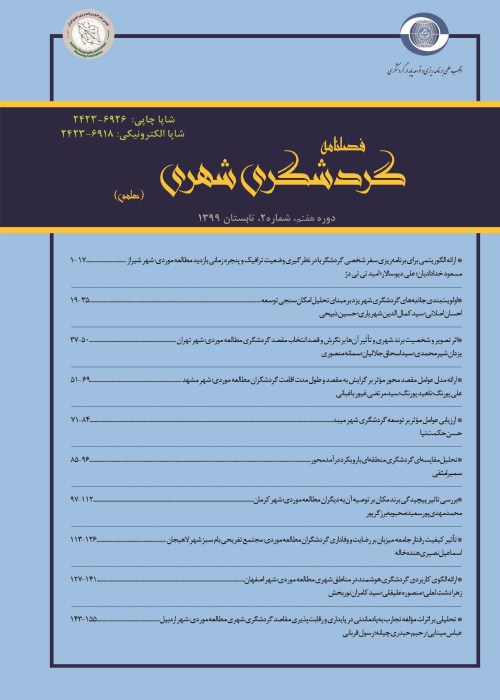Investigating the Role of Geomarketing and its Value Creation in the Urban Tourism Infrastructure Development in Mashhad
This study aims to Investigating the Role of Geomarketing and its Value Creation in the Urban Tourism Infrastructure Development in Mashhad. The current research, in terms of purpose, is developmental-applied and in terms of method, it is a descriptive survey and is in the category of mixed research. In the qualitative section, the research is based on grounded theory and semi-structured interviews were used to collect information, and data analysis was done by Strauss and Corbin method and paradigm model. Sampling was completed via theoretical sampling method and using targeted (judgmental) techniques, 26 experienced experts and managers in the tourism industry were selected. The results of analyzing the data obtained from the interviews during the open, axial, and selective coding process led to the design and explanation of the model. In the quantitative section, via the Morgan table, the sample size was estimated as 86. A researcher-made questionnaire was used to collect data. To analyze the data, structural equation modeling was used using SmartPLS software. The findings achieved from the interviews during the open, axial, and selective coding process led to the formation of geomarketing models based on the development of urban tourism infrastructure regarding the grounded theory. The results of the quantitative section revealed that geomarketing identity, tourism structure, and environmental characteristics had a significant effect on tourism potential. The results also disclosed that the tourism structure and environmental characteristics have a significant effect on tourism potential. Furthermore, the results revealed that the effect of tourism potential, tourism structure, and environmental characteristics on value creation has been significant. In this regard, value creation has also had a significant effect on urban tourism developmentUrban areas are also important tourist destinations because they have a lot of historical and cultural potential. In these areas, there are many diverse attractions that are a very basic factor in attracting tourists (Movahed et al., 2012). In this regard, in urban tourism, attractiveness is determined by primary and secondary elements. The main elements that constitute the main objectives of visiting a city include visiting historic buildings, textures and historic neighborhoods of the city and special events, and the secondary elements also support the primary elements and provide services. Visitors to these attractions contribute to the tourism development of the city (Maryse & Georgesa, 2019: 68). Given the importance of urban tourism and the need to provide infrastructure and tourism resources for tourists, one of the basic and essential needs for tourism development is to pay attention to the needs, characteristics and demands of the market as demand and management factors. The use of attractions, services and tourism facilities and factors of tourism supply in urban environments (Akbarian Ronizi and Rastegar, 1398: 26). Therefore, recognizing these motivations and tourist demand is one of the duties of tourism marketers (Behboodi et al., 1397). Accordingly, urban tourism planners need to consider a variety of products and experiences for people with a wide range of motivations and desires. One of the main elements in the marketing of urban tourism infrastructure is attention to demand, which means who has visited urban tourism destinations and its infrastructure, and what factors influence their behavior pattern (Carlisle & et al, 2016: 84). Tourists in urban areas should be able to assess their information needs about the destination (such as types of attractions, access routes, accommodation, transportation, types of tourist maps, etc.) online and be able to plan. Travel. (Taheri, 2009) Georges & Maryse (2019) in a study has studied and analyzed the factors determining the attractiveness of urban tourism, the case of Quebec and Bordeaux. The results showed that to stimulate the attractiveness of tourism, urban communication should be based on elements related to the tourism belt and effectively use social media to convey the relevant features. Since urban public areas play a key role in the attractiveness of tourism, it is recommended that managers do better planning for the development of urban tourism strategy. In this regard, Rahmati and Daneshmandi (2015) have analyzed the spatial patterns of urban tourism (Case study: Tourism spaces of Isfahan). In the present study, the neighborhood analysis of priority areas was performed to locate future tourism spaces with the help of the analysis of the center of the priority area to provide the services needed by the tourist. Mahkouei and Shirani (2016) have studied and analyzed the indicators of a creative city and its relationship with the management of healthy urban development in the metropolis of Isfahan.This research is applied-developmental in terms of purpose and descriptive-survey in terms of method. Specifically, the present study falls into the category of mixed research. In this study, qualitative and quantitative methods were used. The statistical population of the study, in the qualitative section, included experts and managers of the public sector of the tourism industry, 26 of whom were familiar with the discussion of geomarketing and urban tourism factors, were selected as a sample. In a small part, the statistical population includes all managers of the tourism industry. Data collection tools were interviews and questionnaires. The method of data analysis in the qualitative part was based on the data approach of the foundation and using coding and categorization. In the first phase of the research, through open interviews with tourism industry managers, the subject of knowledge is obtained. Also, observing the behavior of company managers will help the researcher to know in depth. Then, based on this and after coding and categorization, the conceptual model of the research is drawn. Then, in the quantitative section based on the designed questionnaire, a quantitative research model was drawn.
- حق عضویت دریافتی صرف حمایت از نشریات عضو و نگهداری، تکمیل و توسعه مگیران میشود.
- پرداخت حق اشتراک و دانلود مقالات اجازه بازنشر آن در سایر رسانههای چاپی و دیجیتال را به کاربر نمیدهد.


